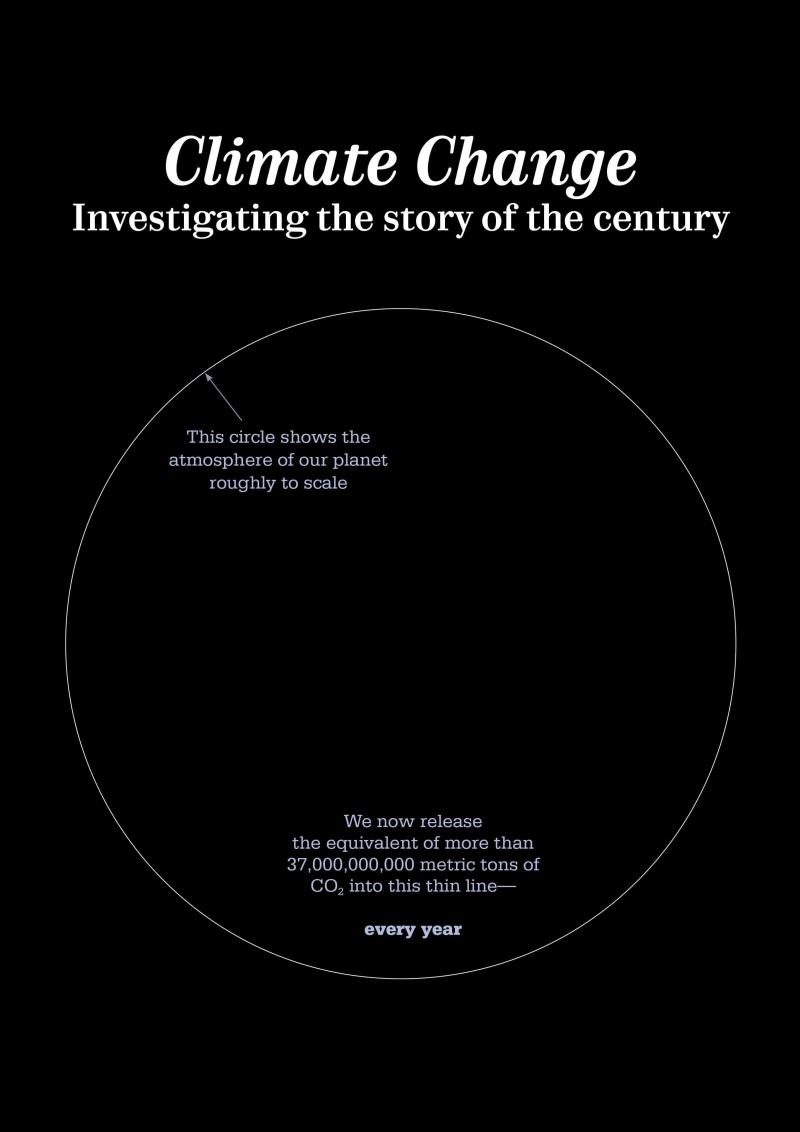Issue:

While it’s harder than ever to ignore the impact that climate change is having on our lives, reporting on such a massive story is not easy. Here are some ways to grab readers’ attention and improve understanding.
By James Fahn
At first glance, climate change may not seem the most obvious subject for investigative journalists to tackle. The science that underlies our understanding of global warming is complex, and so we often rely on technical experts to tell us, for instance, to what extent it exacerbates floods, droughts, hurricanes, heat waves, epidemics and health issues, coastal erosion, the decline of species and other phenomena.
But this is what’s shaping up to be the biggest story of the twenty first century we’re talking about. As with most environmental issues, some people usually poor and marginalized groups like women, youth and indigenous people tend to suffer more than others from climate change, and are less able to adapt to it. And although we all, to a certain extent, are responsible for releasing the greenhouse gases that cause climate change, clearly there are some wealthy consumers, fossil fuel companies, heavy manufacturing and transport industries, logging firms that emit much greater quantities than others, and benefit more from the activities that cause this pollution.
That means climate change is not just an environmental issue, but also an economic and social justice one, making it fertile ground in which investigative journalism can flourish. When it comes to environmental topics, we don’t just follow the money, we also follow the pollution: where it comes from, who benefits and who suffers from it.
What’s more, as climate change has gone from a vague environmental concern several decades ago to a confirmed global phenomenon that is today affecting virtually every aspect of our societyour economy, security, health, livelihoods, food supply and, yes, our politicsit has become ever more ripe for investigation.
So here are 10 promising investigative paths (some of which admittedly overlap with each other, or expand into many subtopics) that journalists can explore to dig up the stories behind what the editor of the New York Times suggests will be the “story of our time.” Even if some of these issues have been covered in some places, there are many countries or regions around the world where such coverage has been lacking.
CLIMATE CHANGE IS NOT JUST AN ENVIRONMENTAL ISSUE, BUT ALSO AN ECONOMIC AND SOCIAL JUSTICE ONE . . . FERTILE GROUND IN WHICH INVESTIGATIVE JOURNALISM CAN FLOURISH
THE FOSSIL FUELS INDUSTRY
As the main driver of greenhouse gas emissions, the coal, oil and gas industries are the most obvious target for investigative reports. There have been some good investigations of the highest profile corporations, such as the extensive probe of Exxon, for which InsideClimate News was named a Pulitzer Prize finalist. But there are many other companies, including some of the world’s largest, which have not been so thoroughly investigated. In particular, those include some of the state owned petroleum companies like Saudi Aramco, Sinopec, China National Petroleum and Kuwait Petroleum, or other mammoth firms like Lukoil, Total and Eni that may be privately owned or publicly listed but still often serve as national champions.
It would be useful to know if these companies, or even more likely the trade associations they belong to, are lobbying for favorable laws, subsidies and regulations; financing politicians who support their industry; spreading disinformation; fighting legislation that addresses climate change; backing climate denier groups; and ignoring the findings of their own scientists.
These companies can also be investigated to see if they’re inflating the hypothesized “carbon bubble,” a potential over valuation of their net worth, which could burst and possibly spark a new financial crisis. These companies are often largely valued based on their stated fossil fuel reserves, but scientists tell us that much of these reserves will have to remain in the ground if we’re to avoid catastrophic climate change, potentially turning some of the reserves into “stranded assets.”
There is also a risk some of these firms could ultimately be held liable for the global warming their products are causing, much as the Master Settlement agreement with the major US tobacco firms required them to pay massive penalties.
In general, coal companies have garnered the most attention from the media understandably, since coal is considered the most polluting of fossil fuels. Oil pipelines and fracking operations have also been subject to much scrutiny, due to environmental risks like explosions, leaks and contaminated water supplies.
Natural gas companies, on the other hand, generally get less attention, partly because burning gas is considered to be a less greenhouse gas intensive fuel. This has lead the industry to argue it should be used as a “bridge fuel” as we move towards renewable energy sources. But there is much yet to be investigated in the natural gas industry: While methane, the main greenhouse gas waste product of natural gas, does not persist in the atmosphere as long as carbon dioxide, it is four times as powerful a warming agent. And even though natural gas companies have recently been found to be leaking far more methane into the atmosphere than previously thought, many of them have been fighting regulations aimed at preventing such leakage a factor that may be relevant in any country from which you are reporting.
OTHER POLLUTING INDUSTRIES
Although the burning of fossil fuels deserves the brunt of the blame for climate change, there are many other industries that are ripe for more in depth reporting. Enterprising reporters can come up with good stories by investigating the supply chains of just about any industry to uncover which processes involve the greatest release of greenhouse gases, but here are a few industries that are particularly relevant:

Annual average temperature across the globe, 1850-2018. This chart is made by Ed Hawkins at the National Centre for Atmospheric Science (University of Reading). In making his charts free for public use, he deliberately avoids using figures, to illustrate the changes as visually and simply as possible. The 1971-2000 average is taken as a the boundary between colder (increasingly dark blue) and hotter (increasingly dark red) using statistical standard deviations between colour shades. showyourstripes.info
AGRICULTURE, LIVESTOCK AND LOGGING
Agriculture, forestry, and land use change are responsible for somewhere between a quarter and a fifth of all the global emissions that cause climate change, and yet it receives consider ably less attention. Industrial agriculture is heavily reliant on the fossil fuel industry. The production of synthetic fertilizer, for instance, has been shown to be a significant producer of greenhouse gases by burning astounding amounts of natural gas and then releasing more heat trapping gasses from soil bacteria. There are climate friendly agricultural techniques available, and journalists should look into why they aren’t more widespread, especially since farming and food security are likely to be heavily impacted by global warming.
The impact of livestock husbandry on the global climate has often drawn snickers, mainly because it is funny to think that cow farts could be contributing to a global crisis. But the dairy and beef industry is responsible for around 8.5 percent of human caused emissions (and in fact, cow belches are a bigger problem than farts, according to NASA). What’s more, a lot of tropical forest that could be used as vital “carbon sinks” places that keep carbon stored rather than being released into the atmosphere and as critical habitat for biodiversity, is being cleared to make way for cattle ranching and soybean farms (particularly in the Amazon) and palm oil plantations (especially in Southeast Asia).
One of the questions journalists are most commonly asked about climate change is, what can individuals do to help address it? Reporters can respond by investigating where our food comes from, how it is produced and shipped, and how that is contributing to greenhouse gas emissions.
TRANSPORTATION
Another cause of climate change where individual consumers can make a difference is in deciding what transportation to use. It is generally well reported that air travel and the use of individual cars is a major contributor to climate change. But there are aspects of the transportation challenge that have received far less attention: the overall impacts of aviation and shipping on climate change and the efforts to regulate these industries, for instance, or the fact that housing policy is a part of climate policy because of the way it affects transportation.
CEMENT AND HEAVY INDUSTRY
Journalists could investigate many industries to uncover their sometimes surprising impact on climate change. Few may know, for instance, that the cement industry generates around 8 percent of man made greenhouse gas emissions. If it were a country, it would be the third largest emitter in the world. And what about other industries, like steel, chemicals, air conditioning or refrigerants? All these are good investigative subjects.
REAL ESTATE AND INFRASTRUCTURE DEVELOPERS
The real estate industry deserves special mention here, not just because it uses a lot of concrete, or because housing policies have such a big impact on transportation options (and thus on emissions), but also because real estate and other infrastructure developers have such tremendous clout over climate related policies, and even the way government communicates the challenge of climate change.
The role of real estate interests in ignoring climate change has received less attention than that of the fossil fuel industry, but there is little doubt that in places it has supported destructive policies, including purposely ignoring scientific models of climate change when determining coastal policies.
Journalists need to be particularly vigilant in coastal and flood prone areas where developers not just of real estate, but also of roads, bridges, seawalls, etc. may be tempted to build and sell infrastructure they know will eventually be inundated. Just as a bubble could be forming in the over valuation of fossil fuel companies, the value of coastal real estate could end up dropping precipitously if homeowners come to realize they can’t adequately protect or insure their homes. Digging deeper, enterprising reporters need to talk to regional planners who face an agonizing quandary: How do they decide what amount of sea level rise or weather related risk to factor into their zoning rules?
Next month: Part II of “Investigating the Story of the Century”: The environmental impact of government rules, foreign aid, and carbon credits.
James Fahn is Executive Director of the Earth Journalism Network at Internews. He is also a lecturer at the Graduate School of Journalism at the University of California at Berkeley, where he teaches international environmental reporting. First published on the Global Investigative Journalism Network website. Reprinted with permission.

